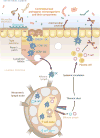Intestinal bacteria and the regulation of immune cell homeostasis
- PMID: 20192812
- PMCID: PMC5610356
- DOI: 10.1146/annurev-immunol-030409-101330
Intestinal bacteria and the regulation of immune cell homeostasis
Abstract
The human intestine is colonized by an estimated 100 trillion bacteria. Some of these bacteria are essential for normal physiology, whereas others have been implicated in the pathogenesis of multiple inflammatory diseases including IBD and asthma. This review examines the influence of signals from intestinal bacteria on the homeostasis of the mammalian immune system in the context of health and disease. We review the bacterial composition of the mammalian intestine, known bacterial-derived immunoregulatory molecules, and the mammalian innate immune receptors that recognize them. We discuss the influence of bacterial-derived signals on immune cell function and the mechanisms by which these signals modulate the development and progression of inflammatory disease. We conclude with an examination of successes and future challenges in using bacterial communities or their products in the prevention or treatment of human disease.
Figures




References
-
- Paszkowski U. Mutualism and parasitism: the yin and yang of plant symbioses. Curr Opin Plant Biol. 2006;9:364–70. - PubMed
-
- Muyskens JB, Guillemin K. Bugs inside bugs: What the fruit fly can teach us about immune and microbial balance in the gut. Cell Host Microbe. 2008;3:117–18. - PubMed
-
- Rae R, Riebesell M, Dinkelacker I, Wang Q, Herrmann M, et al. Isolation of naturally associated bacteria of necromenic pristionchus nematodes and fitness consequences. J Exp Biol. 2008;211:1927–36. - PubMed
-
- Brisbin JT, Gong J, Sharif S. Interactions between commensal bacteria and the gut-associated immune system of the chicken. Anim Health Res Rev. 2008;9:101–10. - PubMed
Publication types
MeSH terms
Substances
Grants and funding
- R01 AI074878/AI/NIAID NIH HHS/United States
- T32-AI060516/AI/NIAID NIH HHS/United States
- T32-CA09140-30/CA/NCI NIH HHS/United States
- T32-AI055438-06/AI/NIAID NIH HHS/United States
- F32-AI72943/AI/NIAID NIH HHS/United States
- T32 CA009140/CA/NCI NIH HHS/United States
- S10 RR024525/RR/NCRR NIH HHS/United States
- T32 AI055438/AI/NIAID NIH HHS/United States
- T32-AI007532-08/AI/NIAID NIH HHS/United States
- T32 AI060516/AI/NIAID NIH HHS/United States
- AI74878/AI/NIAID NIH HHS/United States
- F31 GM082187/GM/NIGMS NIH HHS/United States
- R01 AI061570/AI/NIAID NIH HHS/United States
- T32-AI05528/AI/NIAID NIH HHS/United States
- T32 AI007532/AI/NIAID NIH HHS/United States
- F31-GM082187/GM/NIGMS NIH HHS/United States
- S10RR024525/RR/NCRR NIH HHS/United States
- F32 AI072943/AI/NIAID NIH HHS/United States
- AI61570/AI/NIAID NIH HHS/United States
LinkOut - more resources
Full Text Sources
Other Literature Sources

